Shopify Pricing 2024: Comparison of Plans, Fees & More
Our independent research projects and impartial reviews are funded in part by affiliate commissions, at no extra cost to our readers. Learn more
Using the ecommerce website builder Shopify to set up and run your online store means you have access to sales channels, design flexibility and many website features – but how much is all this costing you?
Shopify offers three pricing plans that range from a basic option ($29 per month) to its most advanced option ($299 per month). You can also take advantage of its $1 a month for 3 months offer. Compared to other builders, Shopify’s value for money score has actually risen since last year’s ratings – it rose from 3 out of 5 to a new score of 3.6 out of 5 in our most recent research, a jump of 20%!
With financial strain imminent in the current economic climate, its reassuring to know Shopify continues to provide great value. Shopify’s also gained so many wonderful features! We’ve created a detailed breakdown of each plan alongside all the features they include to help you make the best choice for your online store.
Shopify Pricing Plans
- Shopify Starter – $5/month
- Basic Shopify – $29/month
- Shopify – $79/month
- Advanced Shopify – $299/month
- Shopify Plus – $2000/month
During our internal testing, Shopify earned a respectable 3.6 out of 5 rating in our “value for money” category. Granted, Shopify is not the cheapest ecommerce builder on the market. But according to our research it is one of the best and it’s getting better every year.
Overview of Shopify’s Plans
| Shopify Plan | Monthly Cost | Paid Annually | Saving | Best for? |
|---|---|---|---|---|
| Shopify Starter | $5 | N/A | N/A | Selling on social media – limited features, optimized for mobile |
| Basic Shopify | $39 | $29 | 25% | Small businesses or storefronts for existing ones |
| Shopify | $105 | $79 | 25% | Larger businesses – more robust tools such as gift cards and cart recovery |
| Advanced Shopify | $399 | $299 | 25% | Companies – low transaction rates and priority shipping |
| Shopify Plus | $2000 | N/A | N/A | Enterprise selling for corporations – used by Sony, Unilever etc |
Further Information
- You can see our full review of Shopify here.
- Check out our ecommerce website builder comparison to see how Shopify stacks up against its competitors.
How Much Is Shopify?
There are three main Shopify pricing plans to choose from. You have Basic Shopify at $29 per month, Shopify at $79 per month, and Advanced Shopify at $299 per month.
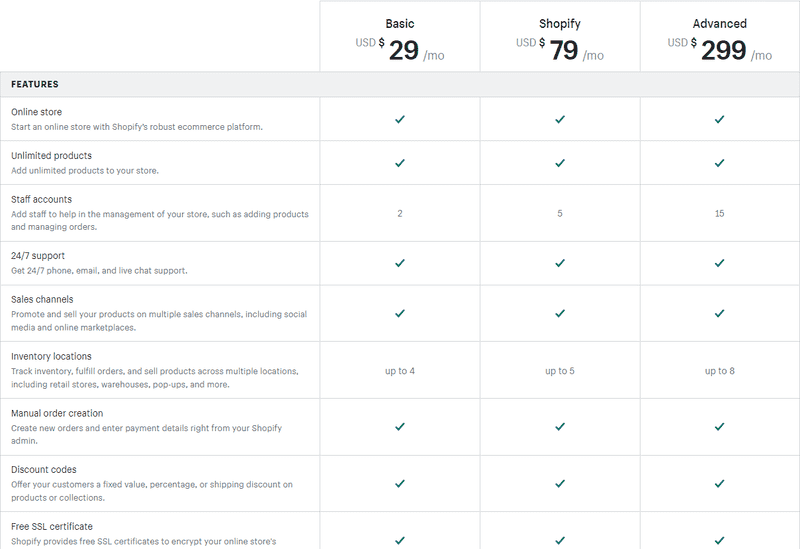
Shopify Plans Comparison
The different plans bring with them different features and abilities. Overall, Shopify provided a good amount of features as its price rose last year, raising its feature vs price score in our metric by 33.3% from 3 to 4 out of 5. This was due to the real strides Shopify made with in-built tools, rather than relying on plug-ins, such as the new AI feature Shopify Magic.
It’s worth noting that all plans charge a transaction fee unless you opt to use Shopify Payments, which reduces the Starter plan fee to 5% and totally removes transaction fees on the Basic Shopify, Shopify, and Advanced plans. Here’s the rundown of exactly what each plan offers.
You can click here to see the actual pricing table on Shopify’s website.
Shopify Starter ($5/month)
If you just plan to sell through social media apps like Instagram and Facebook, then the Shopify Starter is for you! Mobile optimized, you won’t have an actual publicly visible website, just a link to a store you can put on your social media pages. You still get unlimited products, blogging features, free SSL certificates, and abandoned cart recovery like other Shopify plans.
However, for only $5 per month, expect some limitations. The plan is online only, and you get no discount codes or reporting of any kind, plus you will have to pay the highest credit card transaction fee of any of the plans: 5% + 30¢ USD online.
Basic Shopify ($29/month)
Starting a small business, or trying to build an online storefront for an existing one? If your store is tiny, and you just need a little ecommerce functionality, Basic Shopify is the plan for you.
You get unlimited products and abandoned cart recovery like the other plans, plus you will have an actual website you can edit and customize to your liking. You can also accept payments offline for the transaction rate of 2.7% + 0¢.
But if your products are expensive or you sell a lot of them, the slightly more pricey 2.9% + 30¢ transaction fee will add up fast.
Shopify ($79/month)
If your small business is growing rapidly, you’ll need a robust website. The Shopify plan includes data reports, which are super useful in tracking the success of your store, plus all the regular features like gift cards, free SSL certificates, and abandoned cart recovery.
The transaction fees are also lower for this plan, costing 2.6% + 30¢ for online and 2.5% + 0¢ for in-person payments.
A small business might not miss these features, but the bigger you grow, the more revenue you’ll add. If your site currently returns around $5000 in monthly revenue, then this is the plan for you.
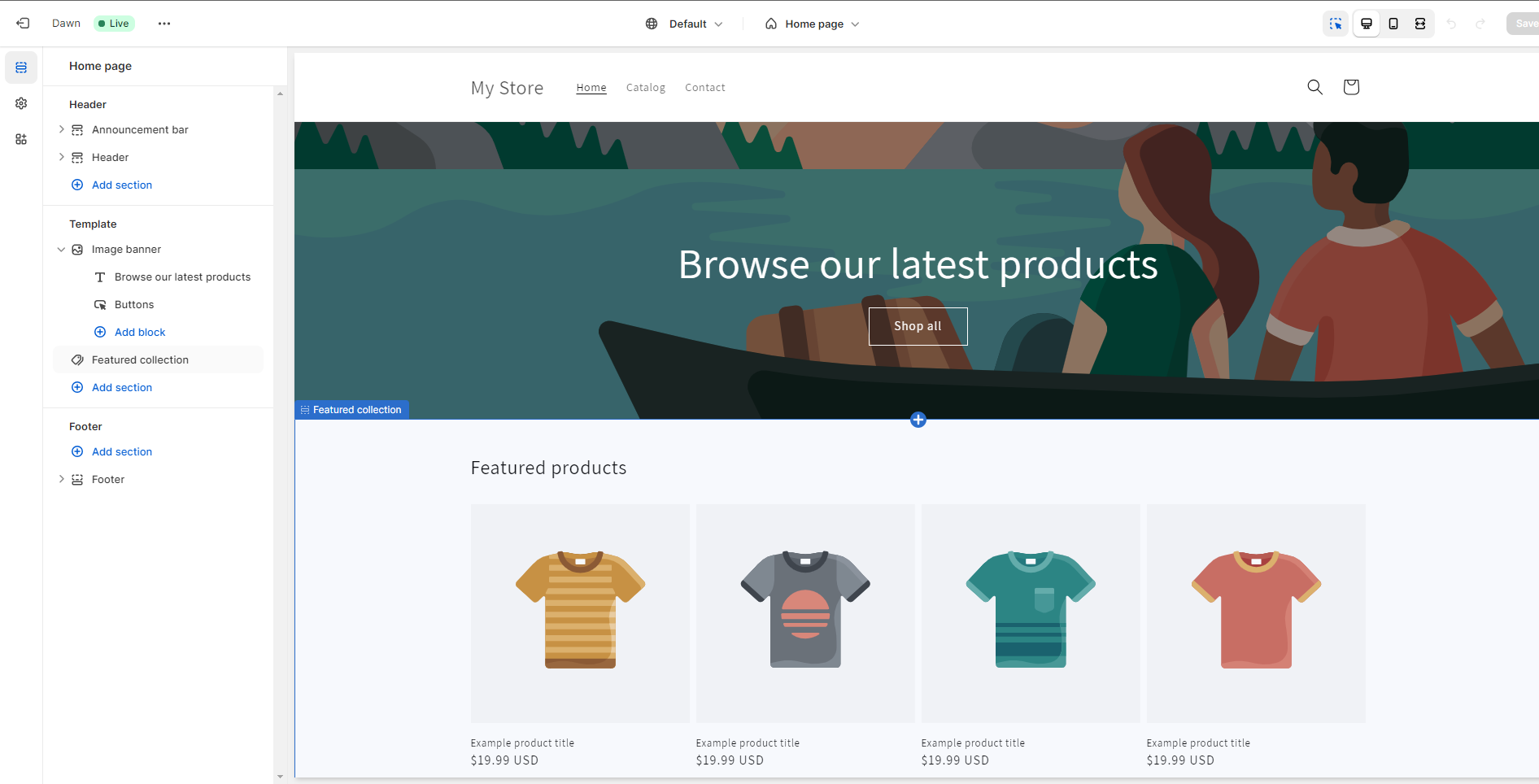
Advanced Shopify ($299/month)
A medium to large online business can always grow more. If your goal is to grow ten times larger, Advanced Shopify comes with delivery and store pickup included and even more advanced reporting. As expected, you get all the other included features (SSL certificate, blogging, cart recovery, discount codes, gift cards) too.
The transaction fees are also rock-bottom. 2.4% + 30¢ for online and 2.4% + 0¢ for in-person. This option is designed for companies with monthly revenues in excess of $10,000. Sure, it’s pricey, but the businesses using this plan can recoup some or all of the monthly cost thanks to the additional features and lower fees.
Shopify Plus ($2000/month)
Top-of-the-range support, only for corporate stores and enterprises. You get the full range of features and then some.
Prices are advertised to start at $2000 per month, but in order to get Shopify Plus you have to be in contact with their sales team.
- Credit Card Rates – decreases marginally for higher plans
- Transaction Fees – decreases significantly for higher plans
- Abandoned Cart Recovery – very useful tool to help you earn more profits automatically.
Now that you’ve compared your options, feel free to click the button below and start testing out the plan that’s best for you!
More Information
- Interview with TileCloud: Read all about how this successful online brand went from Shopify’s Basic plan to Shopify Plus
How to Save 50% on Shopify
One thing you should note is that on Shopify’s pricing page, the monthly price for each plan assumes you pay on a month-to-month plan.
What this means is that if you decide to cancel, you just stop paying. Period.
If you decide to go on the 1-year plans, you save up to 50% respectively. But this is only for the first year, however. Afterward, it will return to the normal prices.
Shopify Prices: Monthly vs Annual Costs
| Shopify Pricing Plans | Shopify Basic | Shopify | Shopify Advanced |
|---|---|---|---|
| Monthly | $39 | $105 | $399 |
| 1-Year $/month | $29 | $79 | $299 |
| Savings | 25% | 25% | 25% |
All too often, businesses fall into the trap of settling into a month-by-month plan, and not really giving it much thought. Granted, with a month-by-month plan, you’ve got a lot of flexibility.
Shopify had the highest customer score, making it the best ecommerce platform in our user testing with a 4.7 out of 5. Remember, you can make use of Shopify’s free trial first, and then get an additional three months for only $1 per month after that.
Currently, Shopify has three months for $1/month deal for new members. If you are nervous about starting up with Shopify, this a low-cost way to use its full features with little expense to yourself!
Does Shopify Charge for Refunds?
No, Shopify does not charge a transaction fee for a fully refunded transaction. Shopify automatically removes the charge or, if it has already billed you, will issue you a credit on your next invoice.
However, if a purchase has only been partially refunded, Shopify still allows the original transaction fee to remain.
Does Shopify Have any Hidden Fees?
Shopify doesn’t have any hidden fees: You’ll pay for your specific plan, and then you’ll pay an additional transaction fee for every transaction made on your store. While you can also buy any additional apps or domain names you want, you shouldn’t be surprised by anything on your invoice.
Does Shopify Offer Discounted Price Plans?
Yes, Shopify offers a 25% discount when you sign up for one year. The subscription needs to be paid upfront, too.
There’s also the $1 for the first 3 months deal Shopify currently has, which slices $84 off your yearly Shopufy bill.
What About Shopify Starter and Shopify Plus?
If the pricing for Shopify’s three plans won’t work for you, don’t despair. Shopify has a super inexpensive option and an enterprise-level one — even if neither one gives you a website, exactly. Here’s what these plans offer.
Shopify Starter
The Shopify Starter plan won’t give you a complete online store. Instead, you get access to the basics, such as product pages, and Shopify’s checkout experience, to start selling right away through social media platforms and messaging channels.
This option is great for a hobbiest who already has an established corner of the internet, and wants to connect with customers on existing social platforms. It costs just $5/month, and it’s easy enough to upgrade (without losing a thing!) if you want to expand.
Shopify Plus
Shopify Plus is an enterprise-level ecommerce plan targeted at big businesses: You’ll pay for more powerful features and for website hosting, ensuring your site never crashes when traffic surges.
The plan is aimed at operations with $1 million or more in annual revenue and costs $2,000 or more per month. This may sound a lot, but according to Shopify’s own research, worldwide social ecommerce sales are expected to reach $1,698 billion by 2024, so more businesses will need this amount of support as demand rises.
To get a custom quote for Shopify Plus (not listed on the table above), you have to speak to Shopify directly.
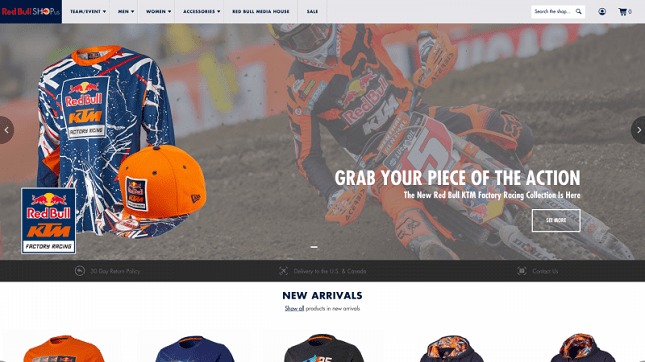
Find Out More
- Shopify Plus (Enterprise Level Users) Review – If you’re in the big leagues and your business generates 6 to 7 figures in sales per year, this is how Shopify Plus can help you grow even more.
- Shopify Starter vs Shopify Plus – See how these two plans at either end of Shopify’s pricing spectrum face off against each other.
- Website Builder Revenue – Found out how much Shopify itself earns each year with our deep dive into its financial reports from 2022.
Shopify Pricing vs Competitor Pricing
Because Shopify is well-equipped for growing or larger stores, it’s easy to assume that it would be a lot more pricey than its competitors. And sure, when you compare the cheapest paid plans of our top ecommerce providers, it does come out towards the more expensive end:
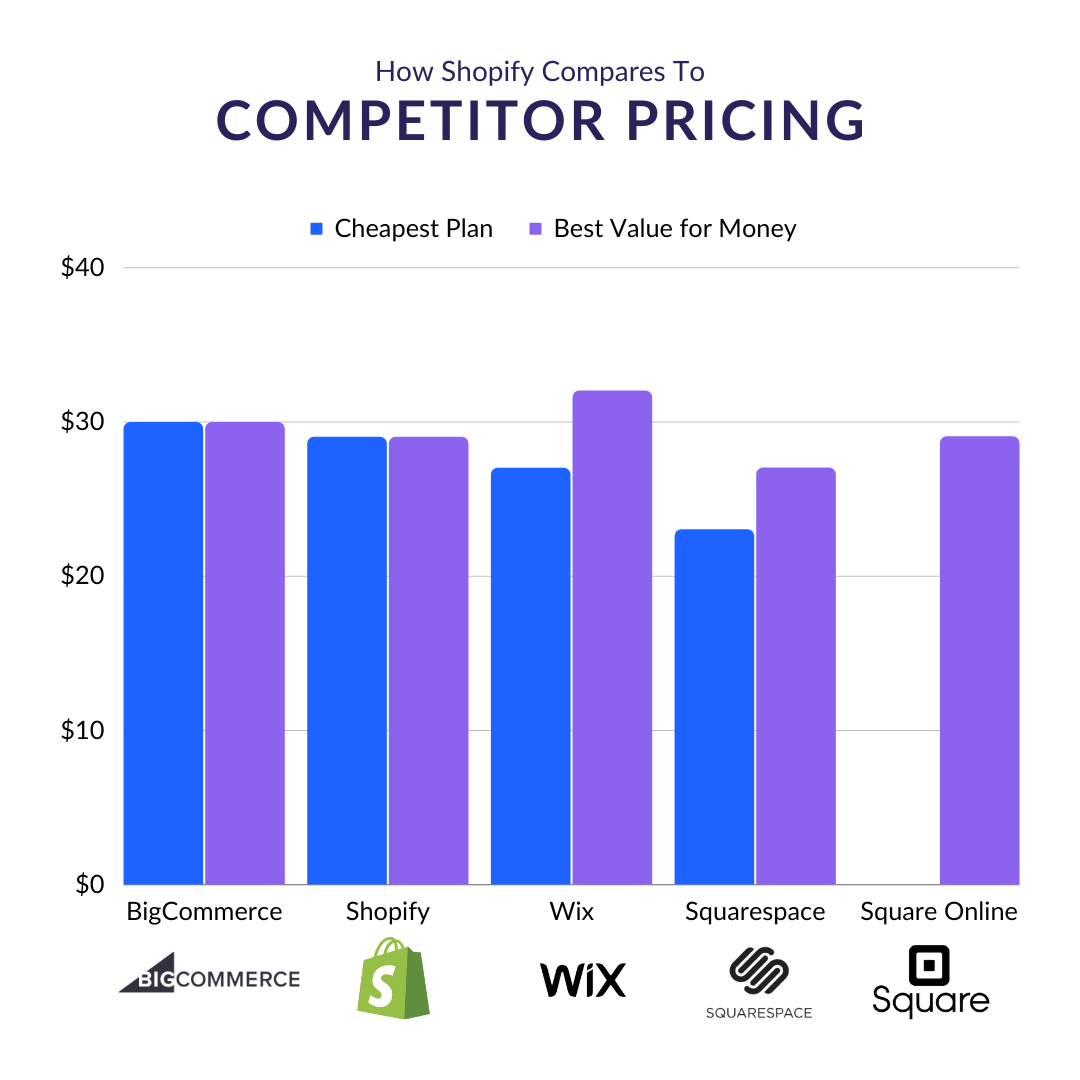
But note just how small the difference in monthly cost is, particularly when you compare the best value plan (as opposed to just the cheapest). All in all, Shopify is holding an accessible entry price point compared to its competitors – albeit one that’s a few dollars a month more.
BigCommerce is Shopify’s closest matchup in terms of features, so it’s interesting to note just how close the starting price is (only $0.95 a month separating them).
There are financial pros and cons of each: Shopify takes an extra 2% transaction fee for purchases not made through Shopify Payments (BigCommerce’s pricing doesn’t take any extra fees), but BigCommerce doesn’t include abandoned cart recovery on its cheapest plan (which Shopify does).
While with Wix vs Shopify, Wix’s initial ecommerce plan is cheaper but its best value for money plan is more expensive than Shopify’s, meaning Shopify takes the win there too.
Since our last update...
Shopify has made a number of improvements to its ecommerce platform to set it apart from its competitors. A major change made recently was the introduction of more Shopify POS terminals for in-person retail. These gadgets sync all sales both online and offline and include features like receipt selections and optional tipping.The Shopify POS is currently on sale for $349, which is a bit steeper than its nearest competitor, Square Online, whose own POS systems sell for $299,
Shopify Credit Card Rates Explained
On Shopify’s pricing table, the Credit Card Rates sections relate to the rates you get charged if you decide to use Shopify Payments to handle your payment processing.
| Plan | Shopify Basic ($29/month) | Shopify ($79/month) | Advanced Shopify ($299/month) |
|---|---|---|---|
| Shopify Payments online credit card rates | 2.9% + 30¢ per transaction | 2.6% + 30¢ per transaction | 2.4% + 30¢ per transaction |
| Shopify Payments in-person credit card rates | 2.7% + 0¢ per transaction | 2.5% + 0¢ per transaction | 2.4% + 0¢ per transaction |
When you use a credit card to purchase online or offline, there is a fee that you will pay no matter what – a payment processing fee.
When you go to your local grocery store to purchase something with your credit card, the grocery store pays a processing fee to their payment processor to collect payment from your bank and deposit it into their bank. That’s just how the world of commerce works. All merchants pay this fee.
That said, the only thing you can control are the credit card rates and that is determined by which payment processor you choose to use.
With Shopify Payments, their credit card rates / payment processing rates for online transactions are as follows:
- Basic Shopify Plan – 2.9% + 30 cents per transaction
- Shopify Plan – 2.6% + 30 cents per transaction
- Advanced Shopify Plan – 2.4% + 30 cents per transaction
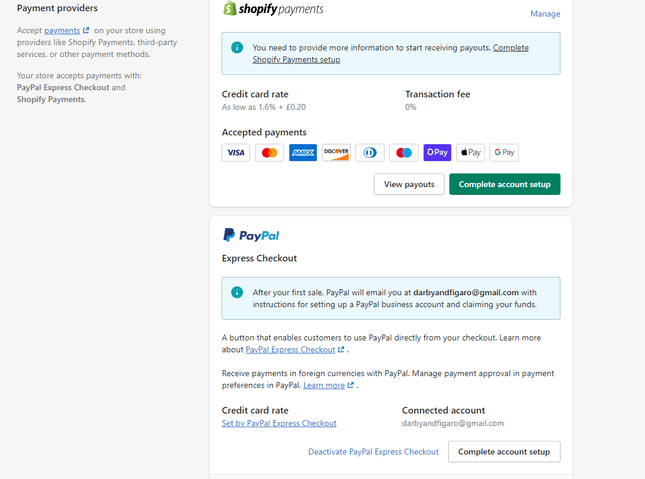
These fees are on a per transaction basis, not on a per-item sold basis. So if someone buys 10 widgets from you in one single transaction, the 30 cents is charged only once and not on each item.
(Note: If you sell products in-person using Shopify’s Point-of-Sale system, the credit card rates are lower)
Shopify Payments is currently available to stores in the United States, Puerto Rico, Canada, the United Kingdom, Ireland, Australia, New Zealand, Hong Kong, and Singapore.
If you’re not located in these countries, Shopify is fully integrated with over 70 different payment processors to accept credit cards from all over the world. You can see their list of payment processors here.
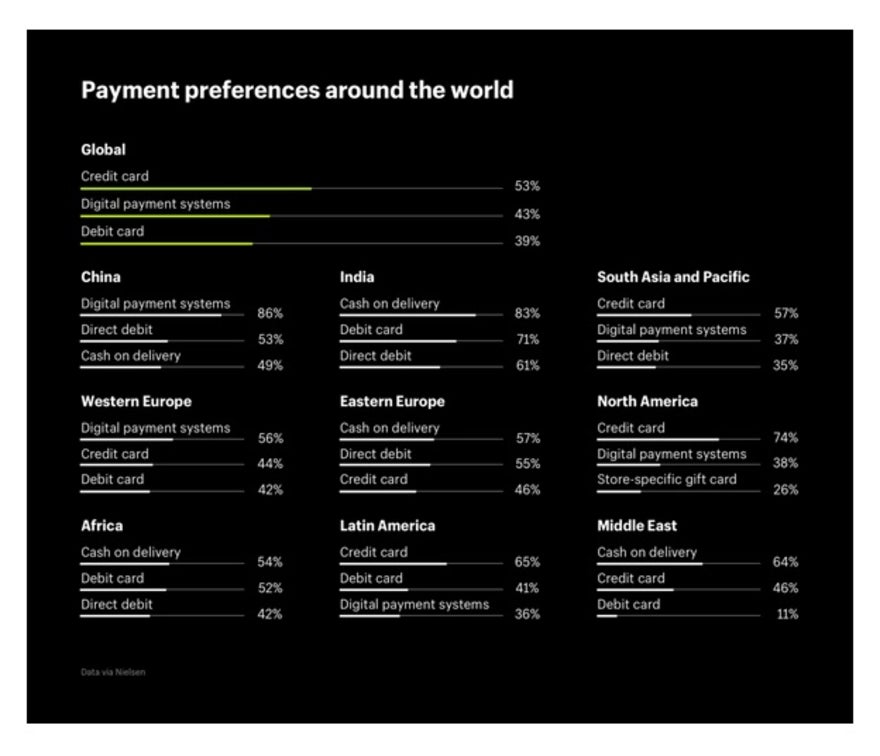
Further Information:
If you’re looking for more information about Shopify payments, check out further discussion in our Shopify Payments Guide.
How to Avoid Shopify Transaction Fees
We see complaints about Shopify’s transaction fees quite often, usually from merchants concerned about the impact on their profits.
The Basic Shopify plan charges 2.9% + $0.30 per transaction, while the Advanced Shopify plan drops just half a percentage point to 2.4% + $0.30.
But Shopify’s transaction fees aren’t your only option, and this Q&A should throw some light on the alternatives.
Of course, nobody likes to pay more fees especially if you don’t think it’s necessary. However, I feel that the concept of Shopify’s transaction fee is commonly misunderstood.
Let’s spend a few minutes investigating why transaction fees exist on top of monthly plan fees, if it’s unique to Shopify, and what you can do.
How Do Transaction Fees Work?
Each time a customer purchases from you (a transaction), depending on which Shopify plan you subscribed to, a transaction fee will be charged. The fees are 2% for the Basic Shopify plan, 1% for the Shopify plan, and 0.5% for the Advanced Shopify plan.
What Are Transaction Fees For?
When shoppers visit your online store, they browse around before making a decision to purchase. It takes resources for Shopify to power your ecommerce website to ensure that it stays up and doesn’t crash on you.
So the idea is that the transaction fees help Shopify keep your store open and operating at optimal levels, no matter how many visitors you have on your website at one given time (10 visitors or a million visitors).
Doesn’t the Monthly Plan Fee Cover This Already?
Yes and no. The monthly fee mainly gives you access to the Shopify platform and selling tools to get your online store published and working. The transaction fees exist to continually keep your store powered, and is only charged when someone purchases your product.
What About Other Similar Ecommerce Builders? Do They Charge Transaction Fees?
Yes, but in different forms.
- For BigCommerce (Shopify’s closest competitor), even though they don’t charge transaction fees for each sale you make, if you generate more than a certain sales dollars per 12 months, they automatically bump you to up to a higher plan so you’ll end up paying more per month. Shopify doesn’t “force” you to upgrade to a higher plan, no matter how much sales you generate per month.
- For Wix (an ideal ecommerce builder for newcomers), you won’t have to pay any transaction charges. However to sell products on Wix, you need to be on either the eCommerce or VIP plan, which are a little bit more expensive per month. Be aware that you will need to pay a percentage per transaction to your payment gateway provider, who each charge their own rate (all payment gateway providers charge this fees).
- For Volusion, they limit the amount of bandwidth you have per month (think of bandwidth also as “power” that keeps your website running. The more shoppers visit your store, the more bandwidth it uses), whereas Shopify gives you unlimited bandwidth. Once you exceed the bandwidth limit with Volusion, you’ll have to purchase additional bandwidth from them (which they don’t list how much it costs, so it’s going to be a nice surprise.)
So transaction fees appear in different forms for ecommerce platforms similar to Shopify.
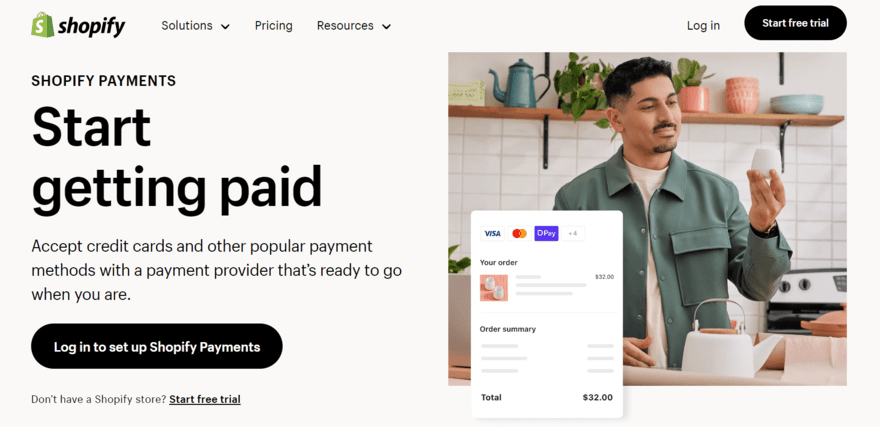
Is There Any Way to Remove Shopify’s Transaction Fees?
Yes. If you use Shopify Payments, they’ll remove all transaction fees.
How Does Using Shopify Payments Remove Transaction Fees?
Shopify Payments help you process payments from your customers (collect money from your customer and deposit it into your bank account). This is the credit card fee as discussed in detail above.
If you use Shopify Payments, then Shopify will earn the credit card fees.
This allows them to waive the transaction fees. So instead of paying transaction fees plus credit card fees, you just have to pay credit card fees if you use Shopify Payments. You’d have to pay this regardless even if you use another payment processor (such as PayPal).
Will Using Shopify Payments Cost Anything More?
No. Shopify will waive transaction fees (saving you money), and the credit card rates are actually lower than payment processors such as PayPal (saving you money). The fee per transaction is fixed, there are no international fees (if you sell to customers outside of your country) and there are no monthly fees.
Is Using Shopify Payments Going to Save Me More Money Compared to Using Other Ecommerce Builders?
Yes. As discussed, if you use BigCommerce, they force you to upgrade to a higher plan if you exceed certain sales levels. Shopify doesn’t require you to upgrade at all. So theoretically, you can sell $1 million worth of products and you can remain subscribed to Shopify’s lowest plan at $29 per month.
With BigCommerce, you’ll have to upgrade to a higher plan and pay more. If you use Volusion, they limit the amount of bandwidth and if you exceed the limit, you’ll have to purchase more from them.
Shopify gives you unlimited bandwidth.
Are A Lot of Shopify Users Using Shopify Payments?
Yes. According to Shopify, 85% of their users are using Shopify Payments when it is available (for users located in the US, Puerto Rico, Canada, the UK, Ireland, Australia, New Zealand, Hong Kong, and Singapore) as at the end of 2017.
This shouldn’t be surprising at all as users get to save transaction fees, have lower credit card processing fees, and can start receiving funds after 2-days.
Transaction Fee Summary
When it comes to fees per sales transaction, it’s best to use Shopify Payments. Not only will Shopify waive all transaction fees, but the credit card processing fees are also lower than PayPal (and most other payment processors).
It doesn’t cost you anything more to use Shopify Payments as you’ll need a payment processor to handle payments anyway.
Additional Shopify Costs to Be Aware Of
Running an ecommerce business comes with a few extra costs beyond the basic website plan. Here are the extra add-ons and charges you might need to consider.
Apps
A variety of third-party providers offer apps designed to work with Shopify websites in the online Shopify app store, home to more than over 6,000 apps.
The prices and the functions can vary wildly: One free app lets customers chat with a business directly though the Apple messages app, while another app offers enterprise level product sourcing and supply chain management and charges $299 per month.
Domain Name
You can register a domain name through Shopify: The service starts at $14 for a 1-year registration. Visit Shopify’s domain name page to search for your business name to see if it’s still free.
Email Hosting
Shopify now offers email hosting, you can use email hosting templates so that you don’t need to code and can manage your campaigns straight on Shopify. You can send up to 10,000 emails for free every month! Then, the charge is just $1 per 1,000 additional emails sent – which is worth it for what you get.
You can even test out email hosting with Shopify’s free trial! Feel free to click through the link below.
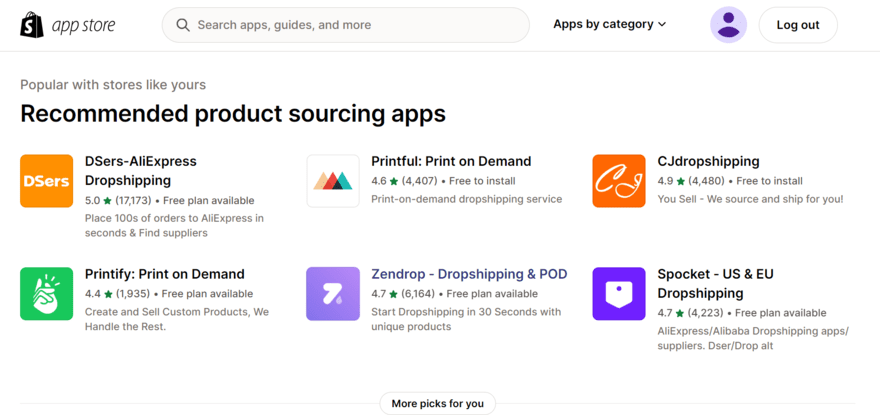

Our Testing Methodology
The most important category of testing a website builder’s pricing is whether it’s good value for money. For the prices of the plans you will be paying for, you want to make sure the builder is delivering and then some.
Using our ecommerce website builder research methodology, we look across all the sales features, design flexibility, customer reviews, and ease of use of Shopify to determine its worth as a platform, and then go deeper to see which of these aspects are available in each plan. For example, each website builder raised its prices in 2023 due to a variety of features, so we’ve analyzed how Shopify balanced its price with features, while also looking at its free trials and if it has any special deals (such as the three-months of Shopify for $1/month discount).
Shopify Prices: Summary
We hope this review has helped you feel more confident about understanding exactly how much it costs you per month to use Shopify.
Let’s recap on how much Shopify costs. It has three main price plans ranging from $29 to $299 per month:
• Basic Shopify Plan – If you have a small store, this plan is ideal!
• Shopify Plan – If your store is rapidly growing then this is the one for you!
• Advanced Shopify Plan – If your goal is to grow 10 times larger, then get what you need on this plan!
Shopify is not quite as cheap as other ecommerce platforms, and the fact it comes with some transaction fees, Shopify isn’t the best value platform on the market. In our research, it scores 3.6 out of 5 for value for money, which is very respectable. To get the most value out of it, we recommend using Shopify Payments to avoid those pesky transaction fees.
That being said, Shopify is one of the best hosted ecommerce builders available in the market today (see our full review here). It’s not the cheapest, with some transaction fees if you don’t opt to use its in-house payment gateway – and yet Shopify scores highly for customer score and sales features.
It has a very broad range of ecommerce tools, offering you access to its App Store (over 6,000 apps), and an ecosystem of theme designers and experts. Shopify is a very strong and fast-growing online store builder.
If you’re looking for an ecommerce builder that is best for large stores, then Shopify is the right platform for you. (But, you can also see our ecommerce website builders comparison for alternatives).
If you’re serious about building a successful online store, Shopify is an excellent platform to help you achieve your goals.
Its plans are not outrageously expensive and are actually quite affordable, giving you the tools and infrastructure to get started. Imagine if you were able to earn $1,000 per month from your business, the $29 per month plan is quite manageable.
Then, if you were to grow your sales to $5,000 per month over time, the monthly cost starts to become negligible.
So, while $29 or $79 per month sounds expensive when you first get started, keep in mind what your business sales goals are over the medium to long-term. If you only want to generate $200 per month, then Shopify is probably not for you.
But if you want to generate thousands of dollars per month over time, Shopify is a strong platform to help you do just that.

FAQs
The commission is 20% of your chosen plan’s monthly price (the Shopify Starter plan is exempt).
So if you were on the Shopify Basic Plan for $29/month, you could earn a monthly $5.80 commission from Shopify as an official partner. Find out more about the program here.
Shipping is available on all of Shopify’s plans and actually has partnerships with several logistic providers like DHL and UPS to help provide it. Simply list your shipping area (eg: North America) and print out a shipping label using the Shopify app. You will need to have accurate package details for location and weight, plus provide your own packaging material.
Found This Guide Helpful?
Did this guide benefit you? Leave a comment below.
Do you know anyone who can benefit from this guide? Send them this page or click on the share buttons on the left.
You’ll be helping us out by spreading the word about our website, and you’ll be helping them out!


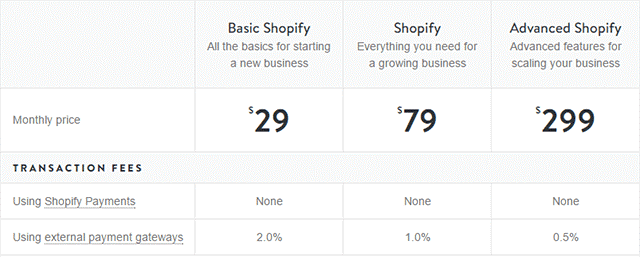
64 comments